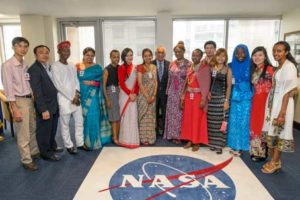AAG Celebrates Earth Day Throughout April with International Student Fellows
International Students Presented Climate Impact Studies Through My Community, Our Earth / SERVIR Fellowship Program

In April, 14 students traveled from all over the world to Washington, D.C., to discuss their efforts using satellite data and mapping technologies to address climate change issues in their regions. The efforts are part of the My Community, Our Earth (MyCOE) / SERVIR Fellowship Program. The student-led projects address a range of issues including agricultural productivity, water resources, sea level change, food safety, forest conservation, and natural disaster planning.
The MyCOE / SERVIR Capstone Event celebrated the culmination of a global program carried out over the past two years, with representative student-led projects highlighting how youth around the world are using remote sensing, GIS, GPS, and geospatial data to address climate change issues in their regions. Several outstanding MyCOE / SERVIR fellows were selected to showcase their work to demonstrate the power of spatial data and geographic thinking. They were nominated by instructors and staff of the MyCOE Program and SERVIR hubs and chosen by U.S. Agency for International Development (USAID) and NASA from among the 120 participants of the 2012-2014 MyCOE / SERVIR Program.
These fellows hail from 10 countries and bring together four staggered regional rounds of 10-month fellowship terms. In early April, fellows met with USAID and NASA staff, scientists, and others in Washington, D.C., during symposia and exhibits convened at agency headquarters. During the presentations at the Washington, D.C. events, students answered questions asked by the public via Twitter, with the entire event broadcast live on NASA Television. A week later, they traveled to Tampa, Fla., to present their work in a featured illustrated paper session during the Association of American Geographers (AAG) annual meeting, which draws nearly 8,000 attendees from more than 60 countries. Through their stories and projects, the fellows showed the power of geographic data and technologies, showcasing the spirit and determination of young people to make a difference in their communities, our Earth.
“It is indeed an enriching experiences. I have always heard about research being so scholarly and professional field and somehow, I was skeptic about my attempt into doing a research. Nonetheless, after being invited and having done with the presentation or having met with those great persons and also after having met a lot of other people from around the globe, I am now a convert! I am encouraged, inspired and energized through this very program. It is been so great, indeed, one of the most fulfilling achievements of my life.” said Lhakpa, a student at the Royal University of Bhutan.
Prasamsa Thapa, a student at Kathmandu University in Nepal said, “The entire event was wonderful and I feel so glad that people appreciated my work. I feel like my hard work really paid off. … I am very much thankful to AAG, NASA, USAID, MyCOE/SERVIR who made us a star and always encourage us to do more good things.”
And, Lateefah Oyinlola, a student at Federal University of Agriculture, Abeokuta, Nigeria, declared, “The ball has successfully been set in motion.”
The MyCOE / SERVIR program supports long-term training of young, emerging scholars in the use of Earth observations, geography, and geospatial technologies to address climate change issues in developing regions. The public-private partnered program provides the mentorship, networking, and professional development necessary to transform innovators into scholars, with the skills to connect their research results to the public and decision makers. It is sponsored by NASA, USAID, and AAG, with the AAG also administering the program. SERVIR, an acronym meaning “to serve” in Spanish, is a joint venture between NASA and USAID. SERVIR works in partnership with leading regional organizations around the globe to help developing countries use information provided by Earth-observing satellites and geospatial technologies to better manage climate risks and sustainability of natural resources.
To learn more about the full My Community, Our Earth / SERVIR program, contact Project Director Dr. Patricia Solís at psolis [at] aag [dot] org. Or, visit https://www.aag.org/mycoe.servir. Read more detailed information on the NASA event.
AAG Continues Its Commitment to Geography Throughout the Year with Youth TechCamps Program
Later this summer, outstanding U.S. high school students will be selected to form teams with their scholastic counterparts in Bolivia, Panama, or South Africa to collaborate online and in person at one of three rounds of training events in these countries to address the theme of GeoTechnologies for Climate Change & Environment. Students will be given academic preparation, orientation, cultural exchange activities, mentoring and training in use of geotechnologies such as online mapping, community GIS, mobile GPS, and crowdmapping. Their work will be featured in an online project fair and showcased at national venues.
For more information, go to https://www.aag.org/cs/techcamps.